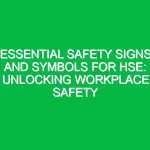Introduction
In today’s fast-paced work environments, ensuring the safety and well-being of employees is more critical than ever. Health, Safety, and Environment (HSE) safety procedures are essential frameworks designed to mitigate risks and foster safe working conditions. These procedures encompass a variety of practices aimed at protecting workers from accidents, injuries, and health hazards while also safeguarding the environment. Understanding and implementing effective safety procedures not only comply with legal requirements but also cultivate a culture of safety that can significantly enhance overall productivity and morale.
Understanding Safety Procedures in the HSE Context
Safety procedures refer to the systematic methods and protocols developed to ensure a safe working environment. In the HSE context, these procedures are not merely a checklist of actions; they are comprehensive strategies that involve risk assessment, incident reporting, training, and continuous improvement. Adopting these procedures is crucial for organizations looking to minimize workplace accidents and ensure compliance with safety regulations.
The Importance of Safety Procedures
Implementing robust safety procedures has numerous benefits, including:
- Risk Reduction: Proper safety procedures help identify potential hazards and implement controls to eliminate or reduce risks.
- Legal Compliance: Many industries are governed by strict regulations. Adhering to safety procedures ensures compliance and helps avoid legal issues.
- Enhanced Productivity: A safe work environment contributes to higher employee morale and productivity, as workers feel secure and valued.
- Reduced Costs: Fewer workplace accidents lead to lower insurance premiums and reduced costs associated with downtime and legal fees.
Key Components of HSE Safety Procedures
Essential HSE safety procedures can be broken down into several key components:
1. Risk Assessment
Risk assessment is the cornerstone of effective safety procedures. This process involves identifying potential hazards, evaluating the risks associated with those hazards, and determining appropriate controls. For instance, in a manufacturing facility, a risk assessment might identify machinery as a potential hazard. The assessment would then evaluate the likelihood of accidents and suggest safety measures such as guarding mechanisms, emergency stops, and personal protective equipment (PPE).
2. Incident Reporting and Investigation
Encouraging employees to report incidents and near misses is crucial for improving safety procedures. An effective incident reporting system allows organizations to analyze trends, identify root causes, and implement corrective actions. For example, if a worker reports a slip and fall incident, the investigation might reveal that the floor was wet due to a leak. Addressing this issue proactively can prevent future accidents.
3. Training and Awareness
Regular training sessions ensure that employees are familiar with safety procedures and understand the importance of adhering to them. Training should be tailored to specific roles and hazards present in the workplace. A construction company, for instance, might conduct fall protection training for roofers, ensuring they are equipped with the knowledge to work safely at heights.
4. Emergency Preparedness
Emergency preparedness procedures outline the steps to take in case of an emergency, such as a fire, chemical spill, or natural disaster. These procedures typically include evacuation plans, emergency contact information, and first aid protocols. Conducting regular drills helps ensure that employees know how to respond in emergencies, greatly reducing panic and confusion during actual incidents.
5. Continuous Improvement
Safety procedures should not be static. Organizations must regularly review and update their safety protocols based on new information, technological advancements, and regulatory changes. Establishing a safety committee that meets regularly to discuss safety performance and make recommendations can facilitate continuous improvement.
Potential Hazards and Risk Considerations
Understanding potential hazards is critical for developing effective safety procedures. Common workplace hazards include:
- Physical Hazards: These include slips, trips, falls, and injuries from machinery.
- Chemical Hazards: Exposure to harmful substances can occur in various industries, necessitating stringent safety measures.
- Biological Hazards: In healthcare and research settings, exposure to viruses and bacteria presents significant risks.
- Ergonomic Hazards: Poor workstation design can lead to musculoskeletal disorders.
Identifying these hazards is the first step in implementing effective safety procedures. For example, an office environment might address ergonomic hazards by providing adjustable chairs and desks, while a chemical plant would focus on proper labeling, storage, and handling of hazardous substances.
Best Practices for Implementing Safety Procedures
To maximize the effectiveness of safety procedures, organizations should consider the following best practices:
1. Leadership Commitment
Leadership must demonstrate a commitment to safety. This includes allocating resources for safety training, equipment, and personnel. When employees see that management prioritizes safety, they are more likely to embrace the culture of safety themselves.
2. Employee Involvement
Engaging employees in the development and implementation of safety procedures fosters ownership and accountability. Employees can provide valuable insights into potential hazards and improvements to existing safety measures.
3. Clear Communication
Effective communication is key to ensuring that all employees understand safety procedures. Organizations should utilize multiple channels, such as meetings, emails, and signage, to reinforce safety messages.
4. Regular Audits and Inspections
Conducting regular safety audits and inspections helps identify discrepancies between established safety procedures and actual practices. This proactive approach enables organizations to address issues before they lead to accidents.
5. Use of Technology
Advancements in technology can enhance safety procedures. For example, wearable technology can monitor workers’ health metrics and alert them to unsafe conditions, while software solutions can streamline incident reporting and analysis.
Regulations and Standards Governing Safety Procedures
Various regulations and standards govern safety procedures, depending on the industry and location. In the United States, the Occupational Safety and Health Administration (OSHA) sets forth regulations to ensure workplace safety. Compliance with these regulations is mandatory, and failure to adhere can result in severe penalties.
Additionally, international standards such as ISO 45001 provide a framework for organizations to manage occupational health and safety. These standards emphasize the importance of leadership, worker participation, and continuous improvement in safety management systems.
Conclusion
In conclusion, safety procedures are essential in fostering a safe work environment within the HSE domain. By implementing robust safety procedures, organizations can significantly reduce risks, comply with regulations, and promote a culture of safety. The benefits—ranging from enhanced productivity to reduced costs—are clear. As we continue to face new challenges in the workplace, prioritizing health, safety, and environmental sustainability must remain at the forefront of organizational values. By taking action today, we can unlock a safer work environment for everyone.


